Peek Behind the Curtain: My Monthly Writing Flow
 Introduction
Introduction“Readers want a behind-the-scenes look at your process.”
And writers want to know how I can write and publish at the pace I do.
I end up doing a brief “elevator” recap for people who want to know my writing process, but what if they want to do a deeper dive? What if we only have 30 seconds and they want a longer explanation? It also takes me time and energy to briefly summarize t my process every time I answer a question about it in writer’s groups. Posting it here, I can satisfy readers who are curious about my process and direct authors who are interested here with a link.
Monthly Workflow1. Last week of the monthDuring the last week each month, I begin planning for the next month’s book.
Obsidian:My use of Obsidian for writing is recorded in a few blog posts, such as Organize and Write Your Next Novel with Obsidian.
To kick things off, I create a new folder for the new book in the series folder and opt-drag the subfolders and documents from my “new book template” folder over. This provides the initial infrastructure for the book. (Obsidian uses folders/files stored on your hard drive, not a cloud-based database.)


I begin by brainstorm using mindmapping the current state of affairs in the series and possible directions to go, listing and reviewing open loops I may have in the series, and reviewing any other notes I may have on ideas for the series.

Once a storyline or idea starts to gel, I use a variation of the Snowflake Method: starting with a one-sentence logline, expanding to a five-line summary, back-cover copy, and other marketing metadata, then expanding again to an outline and character sketches. All of this takes place in Obsidian. This is where all of the action happens.
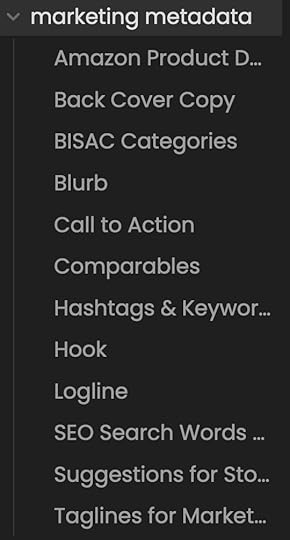

As part of this planning process, I create my cover and title (before beginning the book). I will make any adjustments to the back cover copy/product blurb after the story is drafted. It never goes exactly where I expected.

I create my research notes (on poisons, forensic techniques, cultural settings, etc.) in Obsidian. Research notes that may be reused in later books will be copied to my main research files database after the book is drafted. That way I don’t have to remember which bit of research was used for each individual book.


I prepare character sheets, which are supplemented with pinned images of character models for consistent visual reference
 Todoist:
Todoist: Todoist is my project and task manager. For each new book I import my master project template, which includes planning tasks, drafting the book, getting it through the publication process, over 150 tasks for each book. This template is stored as an Excel spreadsheet so that I can add the book title and publication date, and it generates the descriptions and due dates for the rest of the tasks to be imported into Todoist.

 2. Drafting (Days 1–20)Time-Blocking in Fantastical (Google Calendar)
2. Drafting (Days 1–20)Time-Blocking in Fantastical (Google Calendar)My writing timeslots are blocked out in yellow (e.g., 8 am–9:30 am, 12:30 pm–3:00 pm, 6:00 pm-8:00 pm) six days a week. I do sprints in whatever group I can (I’ve got a good messenger group right now, but it seems like all sprint groups peter out sooner or later.)
 Daily Word Quota:
Daily Word Quota: My goal is 6,000 words per day Monday through Saturday, with Sunday as a rest day. I generally begin with a review of the summary of the previous day’s work, reading through the last 500-1000 words, and writing out thoughts and ideas about the next scenes in my Rocketbook. Then I jump into sprints.
 Progress Tracking:
Progress Tracking: I generally type all of the day’s work in one file, so I can see word count at a glance. Sometimes I like to write in the OhWrite! Global Room, because it is fun to collect the stars and occasionally chat with the other writers there. The OhWrite editor window is a markdown editor, so I can use all of the same formatting as I use in Obsidian, and I can just copy/paste into the file in Obsidian. After all the words are done, I then use the Note Refactor plugin to split it into chapter files on the H2 headings. I have some custom CSS set up on OhWrite to make it look the way it does below.

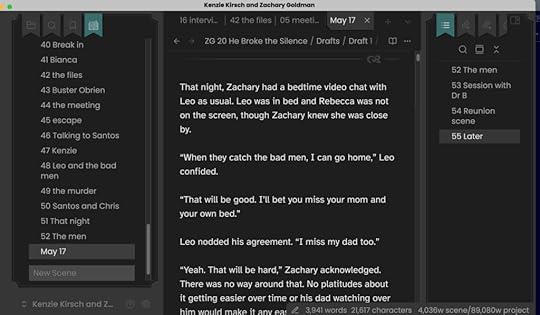

The status bar in Obsidian also tells me how many words are in the project (book) in total.
Sometimes I generate pictures for visualization purposes or future marketing.
At the end of the day, I summarize each chapter, and make note of interesting pull quotes, etc. for marketing purposes.
3. Comprehensive Edit (Days 21–26)Revisions, Structural Review, Line Edits:I track all tweaks, style notes, and unresolved questions in Obsidian using Callouts and Dataview tables to ensure nothing slips through. You might enjoy reading mor ein Elevate Your Writing Process: Using Callouts in Obsidian.



During this editing phase, I perform a deep pass on plot flow, pacing, character arcs, and prose. This is my main edit for that book and takes 4-6 days.
Other Edits:Then I do a second edit on last month’s book. And a polish of the book from the month before. And a final edit of the book going to my editor, and reviewing my editor’s comments on the one being published next month before formatting (Vellum) and sending to ARC readers. Yes, that is 5-7 books to be edited each month.
Other TasksI also perform other tasks such as finalizing the back cover copy, updating the cover, creating mock-ups and pull quotes, creating a web page for the book, listing it for preorder in all stores, and copying research to my main research folder.
4. Next-Month PlanningSeasoningAfter editing this month’s book is complete, I put it aside for 30 days when I can reread it with fresh eyes.
Planning:While I am still editing, I begin planning for the next month, importing the Todoist template and outlining and researching in Obsidian so that on the first day of the next month, I can begin writing without delay.
Project/Task Planning Process 1. Monthly PlanningBecause I follow the same schedule each month, I know my general writing workload at any particular time of the month.
My monthly dashboard, which used to be recorded in an analog bullet journal, with items to be covered during the month is in Todoist in a kanban board view.

The month’s promotions are also tracked in a similar kanban. The red-yellow-green dots are status indicators that tell me at a glance whether the promo is “flight ready” or not.
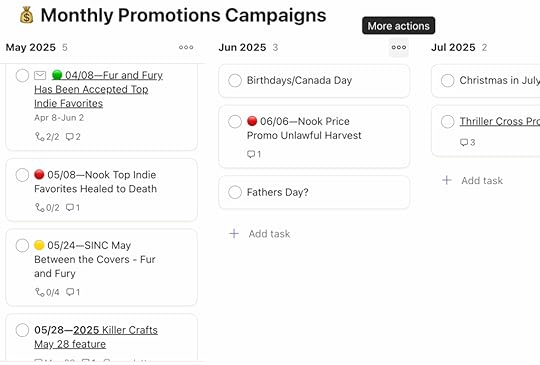
Those two monthly dashboards are exported to Obsidian to be printed for insertion into my A6 binder.
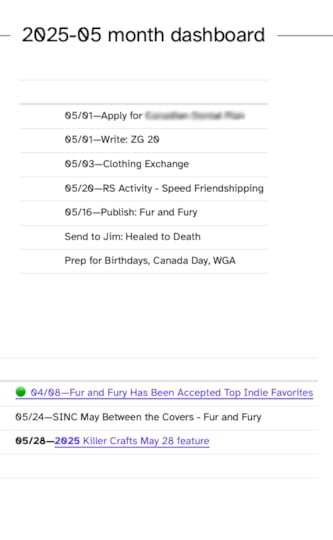 2. Weekly Planning
2. Weekly PlanningEach Sunday I run through a fairly involved weekly planning exercise.
The week plan also include a review of my Fantastical calendar and adjustment of my writing sessions alongside personal commitments (exercise, family time) to ensure work-life balance.
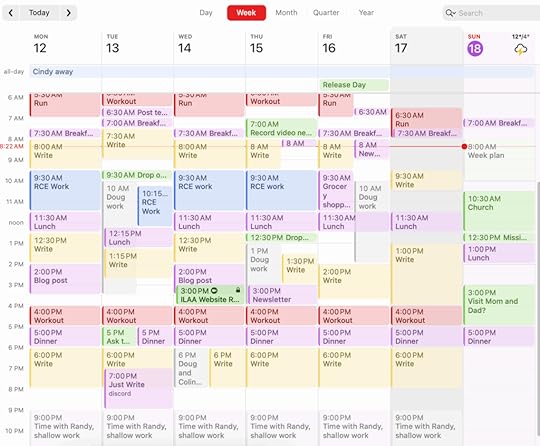
My weekly schedule follows the same flow each week and only needs to be adjusted few outside commitments.
During this weekly review, I set my “Big Rock” tasks for the week: my writing goals, publication prep, holiday prep, family stuff, or other important projects. These are set up on an Alistair Grid in Obsidian, which I print out and place in my A6 binder.
 Daily Workflow1. A6 Analog Binder (Daily Plan)
Daily Workflow1. A6 Analog Binder (Daily Plan)Each night before bed, I write down only my tasks from the week grid on the right-hand page, and my time blocks from Fantastical on the left-hand page. This is my last “commitment” check:
Am I really going to do this? Does anything need to be adjusted?Any possible issues?Having this information in my binder ensures that it is in front of me during the day with no electronic distractions.

 2. Task Execution & Capture
2. Task Execution & CaptureCheck-Off: As I’m completing tasks throughout the day, I check the priority goals off with an “X” in my binder (on both the daily page and the week dashboard). I also have lots of other tasks to do and check off as complete in Todoist.
Deferrals: Any unfinished tasks in my binder are marked with “>” as they are migrated/rescheduled for a later date. And/or they are resheduled in Todoist.
Quick Notes: Brief notes, insights, etc. are jotted down below my priority tasks on the right-hand page.
Recap of ToolsA6 Analog Binder: My plain paper daily planner used for recording top priorities and daily time blocks. There are also tabs for month and week dashboards
Rocketbook: Freeform writing journal/planner/prewriting.
Todoist: My master task manager where project templates reside along with due-dates, labels, and reminders.
Obsidian: My notes and writing—a general vault for day to day work plus series vaults containing everything from outlines through character sheets, to research logs, daily journals, and manuscript compilation via Longform.
Fantastical (Google Calendar): This acts as single source of truth regarding all scheduled activities including writing blocks, meetings, calls, workout sessions, and personal and family commitments.
The post Peek Behind the Curtain: My Monthly Writing Flow first appeared on pdworkman.com.



